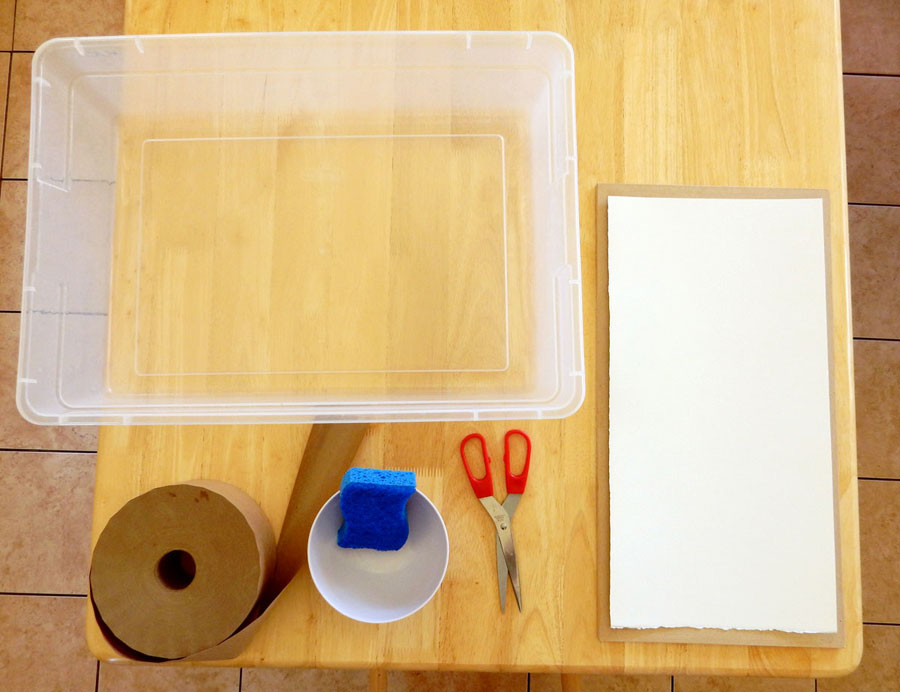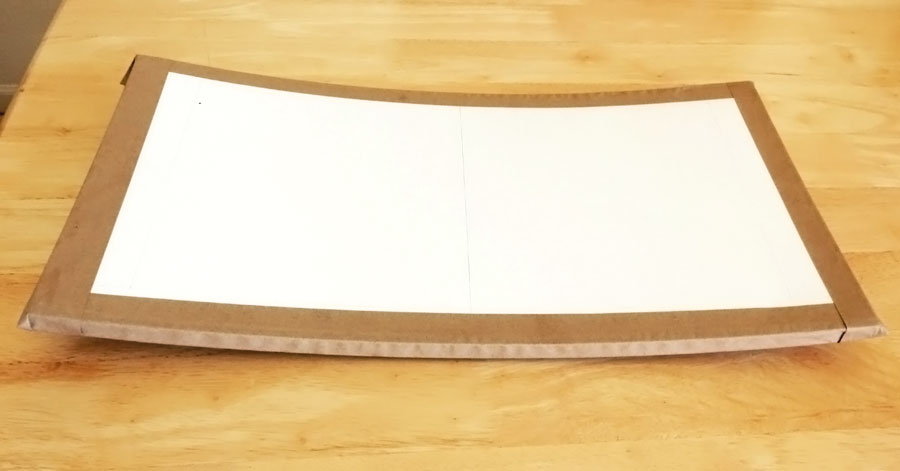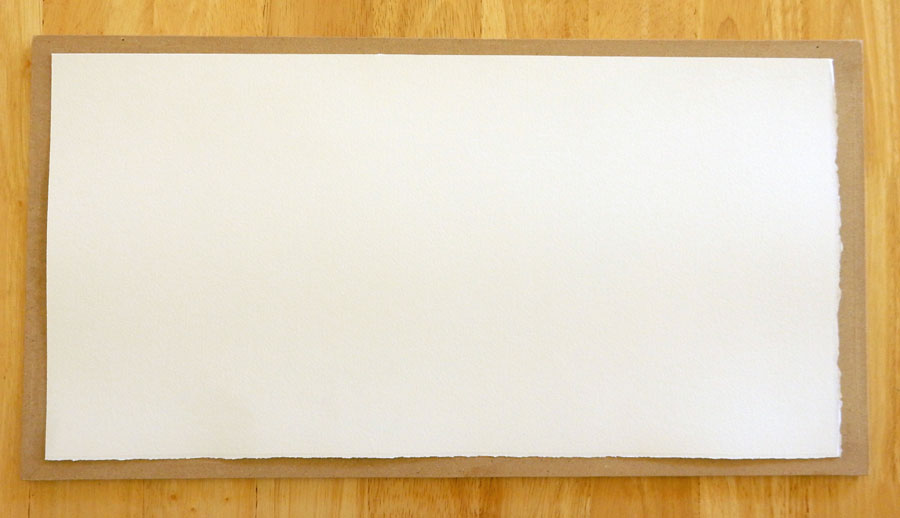Introduction
 Before you begin a watercolor painting, it's often a good idea to prepare your paper by stretching it. The point of stretching watercolor paper is to prevent your paper from rippling and warping as you paint.
Before you begin a watercolor painting, it's often a good idea to prepare your paper by stretching it. The point of stretching watercolor paper is to prevent your paper from rippling and warping as you paint.
Paper fibers absorb water as you paint. They expand when wet, then contract again when drying. The expansion and contraction is what normally causes ripples or warping in paper.
A warped piece of paper is difficult to paint on, since the wet paint tends to pool in the lower sections of the ripples of the paper. This makes it challenging to apply a smooth, consistent color. Furthermore, warped and rippled paper detracts from the image of the finished painting.
A paper that has been stretched, however, will not warp and will therefore continue to be a flat surface during the painting process. It’s much more enjoyable to paint on a flat piece of paper, and looks much nicer on your finished painting.
Stretching paper is a fairly quick and simple process, once you get the hang of it. It consists of soaking the paper to expand the paper fibers and taping it to a board while it's still wet. As it dries, the paper begins to shrink and contract but, because it is taped to a board, stays flat. Later, when you're ready to begin painting, you can use as much water as you like on the paper without having to worry about the paper warping.
Below are step-by-step instructions (with pictures!) of how to stretch watercolor paper.
When to Stretch Paper
 Whether or not to stretch your paper depends on three things: the size of the paper, the thickness of the paper, and the amount of water you plan on using when painting.
Whether or not to stretch your paper depends on three things: the size of the paper, the thickness of the paper, and the amount of water you plan on using when painting.
There is no exact formula for whether or not you should stretch your paper. The thinner the paper, the more easily it ripples. Likewise, the more water you use when painting, the greater the chance of ripples. If your paper is small enough (postcard size, for example), thick enough, and you don't plan on using heavy washes, however, you can probably skip stretching without any negative consequence.
Paper Anatomy: Sizing and Weight
Watercolor paper is made of fibers pressed together and treated with sizing. Sizing refers to the various chemicals added to paper during the manufacturing process which change the way water absorbs when painting. Different brands of paper use different kinds of sizing. This is one of the distinguishing characteristics of different types of paper.
Watercolor paper also comes in different thicknesses, measured in lbs. The three most common thicknesses are 90lb, 140lb and 300lb. This actually refers to the weight of 500 sheets of 22" x 30" paper. The higher the number, the thicker the sheet of paper. A 300lb sheet of paper is thicker than a 90lb sheet, for example.
 Materials and Equipment
Materials and Equipment
- Watercolor paper
- Gummed tape
- Wooden board
- Large plastic container
- Scissors
- Bowl
- Sponge
Watercolor paper: I'm using Arches Hot Press 140lb paper for this example.
Gummed tape: Other names for this are gum tape, gummed paper tape, kraft paper tape or butcher tape. It's very important that you have water-activated tape, since regular tape won't work on wet paper. I'm using 3" Kraft Paper Tape from Blick in this example. You actually only need 1.5"-2" wide tape, but tend I to go through a LOT of tape so find it considerably more cost-efficient to get larger rolls and cut them in half myself.
Be sure to keep your gummed tape roll in a dry place, and not let drops of water fall onto it on accident. Water will activate the tape, making the entire role stick together if you get it wet.
Wooden board: Your board should be at least 1/4" thick. Watercolor paper is surprisingly strong as the paper fibers contract when drying. You need a board strong and thick enough to withstand the pressure. Mine came from the scrap pile of Home Depot (which is a wonderful place to get free boards). I sanded down the edges to avoid splinters while handling them.
 Other kinds of boards: Many people stretch watercolor paper on foam boards or gator boards. I tried this initially, with poor results: the paper warped the entire board into a curved shape as it dried. I suspect this is a result of using a paper sheet that is long and narrow rather than square. The tension is therefore much stronger in one direction. Foam core boards most likely would have worked to stretch a larger sheet of paper, or a piece of paper with more of a square ratio.
Other kinds of boards: Many people stretch watercolor paper on foam boards or gator boards. I tried this initially, with poor results: the paper warped the entire board into a curved shape as it dried. I suspect this is a result of using a paper sheet that is long and narrow rather than square. The tension is therefore much stronger in one direction. Foam core boards most likely would have worked to stretch a larger sheet of paper, or a piece of paper with more of a square ratio.
Large plastic container: This will be used for soaking the paper. It needs to be bigger than your paper, but not necessarily very tall. A large pan works great as well. I find it easier to use a separate container, although a clean bathtub or sink (if it's big enough) also works.
Let's Begin!












The above video shows the process of wetting both sides of the tape and taping one edge of the paper to the board.

Tips & Tricks: Troubleshooting the Stretching Process
Sometimes in the process of drying, the tape peels off the paper on one or more sides. Here are a couple things to keep in mind which might help prevent that.
- Keep your board and paper horizontal while drying. If it's vertical or at an angle, water will drain down to the lower portion, causing the paper to dry unevenly.
- Keep your drying board and paper out of sunlight or excessive heat when drying. The paper can contract unevenly if it dries too quickly, which may result in the tape peeling off of the paper.
- Try using more or less water when moistening the gummed tape. Using too much water is the most common problem. If the sponge is too wet, it might wash off some of the adhesive from the tape. Too little water is a problem as well, as it may not be enough to completely activate all of the adhesive on the tape.
- Use less pressure when wetting the gummed tape. Pressing too hard against the gummed tape my rub off some of the adhesive.
- Soaking your paper too long can also contribute to stretching problems. The longer you soak your paper, the more sizing is dissolved, which allows the paper to absorb yet more water and expand more fully. This results in greater pressure when the paper dries and contracts back to its original size. Try soaking your paper for a shorter period of time.
Fortunately, paper that has failed to stretch is often re-usable. Soaking the gummed tape will release the adhesive and the paper can soaked and stretched again. Keep in mind that every time you soak your paper, more of the sizing is dissolved and removed, which can change the way the paint absorbs into the paper.

